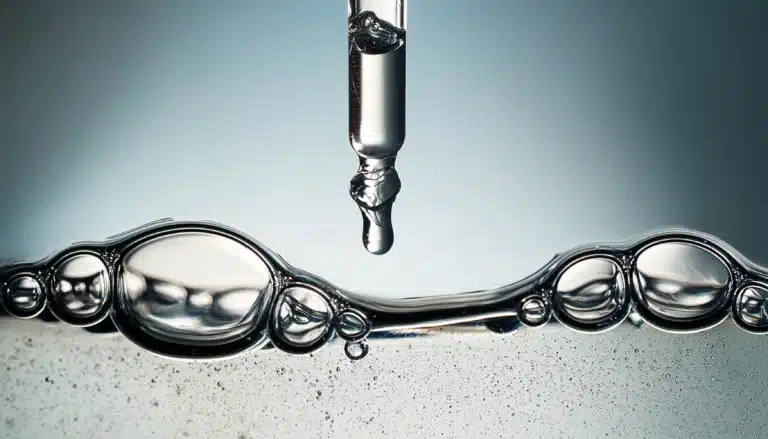Home » Conditions » Nose » Secondary rhinoplasty
medical rhinoplasty est une procédure non chirurgicale qui consiste à injecter un produit de comblement, l’acide hyaluronique, pour corriger des légères imperfections du nez. Contrairement à la rhinoplastie chirurgicale, cette méthode ne nécessite pas d’incision, de période de récupération ou d’anesthésie générale.
La rhinoplastie médicale par injection d’acide hyaluronique est particulièrement intéressante pour les patients ayant déjà subi une rhinoplastie chirurgicale mais qui souhaitent améliorer les résultats de leur première intervention. La medical rhinoplasty on a previously operated nose permet d’ajuster les contours, de corriger certaines imperfections ou de rééquilibrer les volumes de manière douce et sans éviction sociale.
Secondary rhinoplasty with hyaluronic acid is an ideal solution for correcting or enhancing the results of a previous surgical rhinoplasty. This non-invasive technique allows for the refinement of residual imperfections, restoration of symmetry, and reshaping of specific areas of the nose without requiring another surgery.
Grâce aux propriétés de l’acide hyaluronique, il est possible d’obtenir des résultats harmonieux et naturels rapidement et sans éviction sociale. La secondary rhinoplasty without surgery peut améliorer le profil et corriger certains détails pour un nez parfaitement équilibré.
Imperfect results from primary rhinoplasty can be due to a number of factors, such as poor healing, inadequate surgical technique or unrealistic expectations. Sometimes scar tissue forms unpredictably, resulting in asymmetries or irregularities. In addition, the healing process can cause the internal structures of the nose to shift over time.
La détérioration des résultats est possible avec l’âge à cause du vieillissement, des traumatismes ou de changements de qualité de la peau.
La rhinoplastie secondaire est généralement plus complexe qu’une rhinoplastie primaire en raison de la présence de tissus cicatriciels et des modifications anatomiques résultant de la première intervention. La peau et les structures internes du nez peuvent avoir été modifiées de manière importante, ce qui rend plus difficile le remodelage ou la correction des imperfections. De plus, la perte de certains tissus, notamment le cartilage, peut nécessiter des ajustements plus délicats et complexes. L’enjeu principal réside dans la gestion des cicatrices internes qui limitent la flexibilité des tissus et augmentent les risques de complications.

After a surgical rhinoplasty, certaines imperfections peuvent subsister ou apparaître au fil du temps. Que ce soit en raison d’une asymétrie subtile, d’un affaissement de la structure nasale ou d’un léger défaut de forme, certains patients ne sont pas entièrement satisfaits du résultat final.
• Résultats chirurgicaux imparfaits : même après une intervention chirurgicale réalisée par un chirurgien expérimenté, le résultat final peut parfois présenter des légères imperfections. Les patients peuvent constater : des asymétries, des creux ou des bosses persistants, un affaissement du cartilage, une pointe du nez trop relevée ou trop abaissée. Ces petits défauts peuvent ne pas nécessiter une seconde intervention chirurgicale, mais peuvent être suffisamment gênants pour que le patient souhaite une correction.
- Non-invasive correction: to avoid having to undergo another operation, medical rhinoplasty is an ideal alternative to a secondary surgical rhinoplasty. It allows the results of a previous rhinoplasty to be improved without the risks associated with a new operation, such as post-operative complications, anaesthesia or the recovery period.
• Réversibilité et ajustement des résultats : l’avantage de l’acide hyaluronique réside dans sa réversibilité. L’acide hyaluronique est un produit résorbable.
• Amélioration progressive et entretien des résultats : une autre raison de choisir la rhinoplastie médicale après une chirurgie est la possibilité de modifier progressivement les résultats. Contrairement à la chirurgie, dont le résultat est définitif, cette approche permet d’ajuster le résultat dans le temps, en fonction de l’évolution des tissus et des attentes du patient.

Medical secondary rhinoplasty allows for the correction of specific areas of the nose in just a few minutes, with immediate and natural results.
La pointe du nez est une zone délicate qui peut parfois sembler trop relevée ou, à l’inverse, tombante après une rhinoplastie.
In this situation, the feasibility of medical rhinoplasty needs to be analysed on a case-by-case basis.
It is not possible to lower the tip of the nose using hyaluronic acid injections. It is possible to inject hyaluronic acid into the bridge of the nose to give a false impression of a lower tip, but this is not possible for all patients.
La remontée de la pointe du nez est souvent impossible à cause de la fibrose post-chirurgicale. Les techniques médicales permettent d’améliorer légèrement la position de la pointe du nez, mais cette remontée reste modérée et ne peut pas se comparer à une correction chirurgicale.
Dans certains cas, une légère bosse peut persister après une chirurgie. Avec l’acide hyaluronique, il est possible de camoufler cette bosse en injectant le produit de part et d’autre de celle-ci pour rectifier le profil nasal.
Après une rhinoplastie chirurgicale, l’arête nasale peut paraître légèrement irrégulière ou creusée. Les injections d’acide hyaluronique peuvent combler ces zones et améliorer ainsi le profil nasal.
Minor asymmetries may persist after surgical rhinoplasty. These small irregularities can be corrected non-invasively through medical rhinoplasty by filling in depressions and balancing the volume on each side of the nose.
La rhinoplastie médicale repose sur l’utilisation de produits injectables, principalement l’acide hyaluronique, mais aussi les fils tenseurs.
hyaluronic acid est le produit le plus couramment utilisé pour la rhinoplastie médicale. Il s’agit d’une substance naturellement présente dans la peau, connue pour sa capacité à retenir l’eau et à augmenter le volume des tissus. Dans le cadre d’une rhinoplastie médicale, l’acide hyaluronique permet de modifier subtilement les contours du nez, d’ajuster les volumes et de lisser les irrégularités.
Les résultats sont visibles immédiatement après l’injection et des corrections peuvent être réalisées selon les besoins du patient.
Les résultats durent généralement entre 9 et 12 mois, selon le type de produit utilisé et la zone injectée.
In some cases, the tensor threads peuvent être utilisés pour redresser la pointe du nez ou modifier certaines zones. La rhinoplasty using tensor threads est souvent combinée avec des injections d’acide hyaluronique pour obtenir un résultat optimal et durable sans chirurgie.

A medical rhinoplasty is a quick and relatively simple procedure.
Before the operation, an initial consultation with Dr Romano enables the results of the first rhinoplasty to be assessed, the feasibility of the procedure to be determined and the areas to be treated.
Il est important de bien comprendre les attentes du patient et de déterminer si la rhinoplastie médicale est adaptée à ses besoins. Le docteur examine la structure du nez, discute des attentes du patient et planifie les corrections nécessaires.
Le docteur injecte l’acide hyaluronique dans des zones précises. Les injections sont réalisées exclusivement à la canule (aiguille dont le bout est rond) avec précision pour corriger les imperfections sans altérer les traits naturels du nez.
Après les injections, le docteur masse délicatement la zone pour répartir uniformément le produit.
The session generally lasts between 5 and 10 minutes.
Après le traitement, de légères rougeurs ou un discret gonflement peuvent apparaître, mais ces réactions transitoires disparaissent rapidement. Le résultat est visible immédiatement et se stabilise progressivement au cours de la semaine suivante.
Before undergoing a medical rhinoplasty, certain precautions must be taken:
• Évitez l’alcool et certains médicaments : il est recommandé d’éviter la consommation d’alcool et les médicaments anti-inflammatoires (comme l’aspirine ou l’ibuprofène) au moins 24 heures avant le traitement pour minimiser le risque d’ecchymoses. Le docteur Romano ne réalise pas de rhinoplastie médicale chez les patients sous antiagrégants plaquettaires (aspirine) ou anticoagulants.
• Arrêtez de fumer : le tabagisme peut augmenter le risque de complications et altérer la qualité de la cicatrisation. Il est donc recommandé de suspendre la consommation de tabac quelques jours avant le traitement.
Après la rhinoplastie médicale, des précautions doivent être respectées pour éviter la survenue de complications ou des anomalies du résultat :
- Avoid applying pressure to the treated area: you can touch, wash and apply creams to the nose, but it is advisable not to apply strong pressure to the skin.
- Avoid wearing glasses (if treating the bridge of the nose) for one week.
- Do not apply ice: contrary to popular belief, applying ice is harmful and can cause the product to harden. If the swelling is bothersome, which is rare, bromelain can be taken.
- Avoid exposure to intense heat for a week.
- Avoid strenuous exercise for the first 48 hours, as this could increase blood flow to the treated area.
Les résultats d’une rhinoplastie médicale sont visibles immédiatement après la séance : le nez est remodelé et les imperfections esthétiques corrigées. Le résultat définitif est obtenu 7 à 15 jours après, , lorsque le gonflement a complètement disparu. Le résultat dure généralement entre 9 et 12 mois, des séances d’entretien annuelles sont nécessaires pour le maintenir.
Le prix d’une rhinoplastie médicale secondaire par injection d’acide hyaluronique est de 750 CHF la seringue. Ce prix concerne les retouches non chirurgicales réalisées après une rhinoplastie antérieure, qu’elle ait été médicale ou chirurgicale.
Dans la majorité des cas, une seule seringue suffit pour harmoniser le dorsum du nez, corriger des creux résiduels ou rééquilibrer les volumes. Le tarif reste donc généralement fixe, sauf indication particulière évaluée lors de la consultation initiale.
Les patients ayant subi une rhinoplastie médicale après une chirurgie sont généralement très satisfaits des résultats. Beaucoup apprécient la simplicité et la rapidité de l’intervention et l’absence d’éviction sociale.
They also appreciate the fact that the treatment allows the imperfections left by the first rhinoplasty to be corrected without having to undergo further surgery.
Les injections d’entretien annuelles permettent d’ajuster le résultat en fonction de l’évolution du visage et des préférences esthétiques du patient qui peuvent évoluer dans le temps.
Medical rhinoplasty can correct minor imperfections or residual asymmetries following surgery, helping avoid the need for another surgical procedure.
Oui, des injections d’acide hyaluronique peuvent corriger des asymétries mineures post-chirurgicales.
Oui, l’acide hyaluronique peut être utilisé pour améliorer la définition de la pointe du nez. Néanmoins, après une chirurgie, le risque de nécrose est trop élevé, cet acte est donc déconseillé.
Yes, injections can smooth out a residual bump, improving the nasal profile.
Yes, for minor corrections, hyaluronic acid injections offer an effective non-surgical alternative.